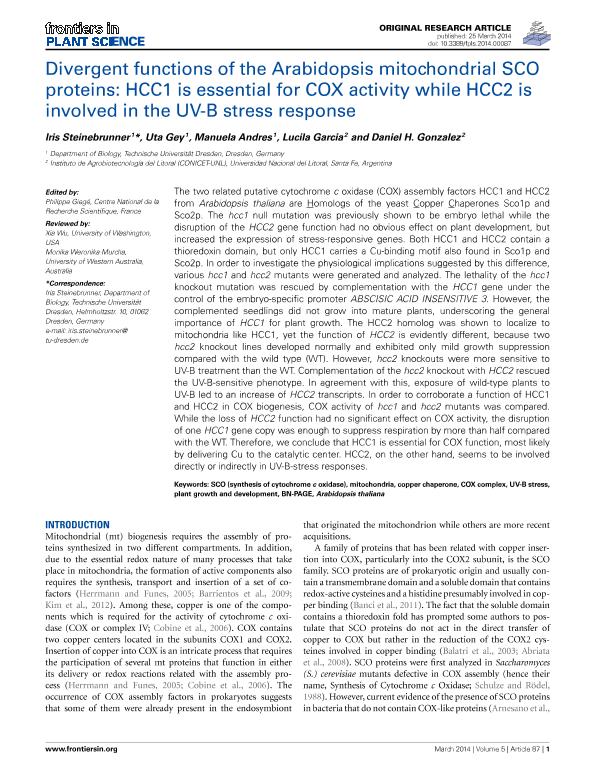Mostrar el registro sencillo del ítem
dc.contributor.author
Steinebrunner, Iris
dc.contributor.author
Gey, Uta
dc.contributor.author
Andres, Manuela
dc.contributor.author
García, Lucila

dc.contributor.author
Gonzalez, Daniel Hector

dc.date.available
2017-02-24T19:11:25Z
dc.date.issued
2014-03
dc.identifier.citation
Steinebrunner, Iris; Gey, Uta; Andres, Manuela; García, Lucila; Gonzalez, Daniel Hector; Divergent functions of the Arabidopsis mitochondrial SCO proteins: HCC1 is essential for COX activity while HCC2 is involved in the UV-B stress response; Frontiers; Frontiers in Plant Science; 5; 87; 3-2014; 1-16
dc.identifier.issn
1664-462X
dc.identifier.uri
http://hdl.handle.net/11336/13394
dc.description.abstract
The two related putative cytochrome c oxidase (COX) assembly factors HCC1 and HCC2 from Arabidopsis thaliana are Homologs of the yeast Copper Chaperones Sco1p and Sco2p. The hcc1 null mutation was previously shown to be embryo lethal while the disruption of the HCC2 gene function had no obvious effect on plant development, but increased the expression of stress-responsive genes. Both HCC1 and HCC2 contain a thioredoxin domain, but only HCC1 carries a Cu-binding motif also found in Sco1p and Sco2p. In order to investigate the physiological implications suggested by this difference, various hcc1 and hcc2 mutants were generated and analyzed. The lethality of the hcc1 knockout mutation was rescued by complementation with the HCC1 gene under the control of the embryo-specific promoter ABSCISIC ACID INSENSITIVE 3. However, the complemented seedlings did not grow into mature plants, underscoring the general importance of HCC1 for plant growth. The HCC2 homolog was shown to localize to mitochondria like HCC1, yet the function of HCC2 is evidently different, because two hcc2 knockout lines developed normally and exhibited only mild growth suppression compared with the wild type (WT). However, hcc2 knockouts were more sensitive to UV-B treatment than the WT. Complementation of the hcc2 knockout with HCC2 rescued the UV-B-sensitive phenotype. In agreement with this, exposure of wild-type plants to UV-B led to an increase of HCC2 transcripts. In order to corroborate a function of HCC1 and HCC2 in COX biogenesis, COX activity of hcc1 and hcc2 mutants was compared. While the loss of HCC2 function had no significant effect on COX activity, the disruption of one HCC1 gene copy was enough to suppress respiration by more than half compared with the WT. Therefore, we conclude that HCC1 is essential for COX function, most likely by delivering Cu to the catalytic center. HCC2, on the other hand, seems to be involved directly or indirectly in UV-B-stress responses.
dc.format
application/pdf
dc.language.iso
eng
dc.publisher
Frontiers

dc.rights
info:eu-repo/semantics/openAccess
dc.rights.uri
https://creativecommons.org/licenses/by-nc-sa/2.5/ar/
dc.subject
Sco
dc.subject
Synthesis of Cytochrome Oxidase
dc.subject
Mitochondria
dc.subject
Copper Chaperone
dc.subject
Cox Complex
dc.subject
Uv-B Stress
dc.subject
Plant Growth And Development
dc.subject
Bn-Page
dc.subject
Arabidopsis Thaliana
dc.subject.classification
Bioquímica y Biología Molecular

dc.subject.classification
Ciencias Biológicas

dc.subject.classification
CIENCIAS NATURALES Y EXACTAS

dc.title
Divergent functions of the Arabidopsis mitochondrial SCO proteins: HCC1 is essential for COX activity while HCC2 is involved in the UV-B stress response
dc.type
info:eu-repo/semantics/article
dc.type
info:ar-repo/semantics/artículo
dc.type
info:eu-repo/semantics/publishedVersion
dc.date.updated
2016-11-23T20:12:57Z
dc.journal.volume
5
dc.journal.number
87
dc.journal.pagination
1-16
dc.journal.pais
Suiza

dc.journal.ciudad
Lausanne
dc.description.fil
Fil: Steinebrunner, Iris. Technische Universität Dresden. Department of Biology; Alemania
dc.description.fil
Fil: Gey, Uta. Technische Universität Dresden. Department of Biology; Alemania
dc.description.fil
Fil: Andres, Manuela. Technische Universität Dresden. Department of Biology; Alemania
dc.description.fil
Fil: García, Lucila. Consejo Nacional de Investigaciones Científicas y Técnicas. Centro Científico Tecnológico Santa Fe. Instituto de Agrobiotecnologia del Litoral; Argentina
dc.description.fil
Fil: Gonzalez, Daniel Hector. Consejo Nacional de Investigaciones Científicas y Técnicas. Centro Científico Tecnológico Santa Fe. Instituto de Agrobiotecnologia del Litoral; Argentina
dc.journal.title
Frontiers in Plant Science
dc.relation.alternativeid
info:eu-repo/semantics/altIdentifier/doi/http://doi.org/10.3389/fpls.2014.00087
dc.relation.alternativeid
info:eu-repo/semantics/altIdentifier/url/http://journal.frontiersin.org/article/10.3389/fpls.2014.00087/full
Archivos asociados
